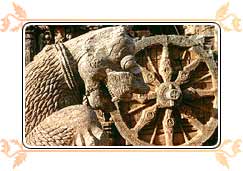| Location: | Konark, Orissa |
| Also Known As: | Black Pagoda & Konarak |
| Built By: | King Narsingha Deva |
| Presiding Deity: | Surya Or The Sun God |
Konark Tourism : Konark Sun Temple is located , in the state of Orissa near the sacred city of Puri. The sun Temple of Konark is dedicated to the sun God or Surya. It is a masterpiece of Orissa's medieval architecture. Sun temples has been declared a world heritage site by UNESCO.
 The
Konark temple is widely known not only for its architectural grandeur but
also for the intricacy and profusion of sculptural work. The entire temple
has been conceived as a chariot of the sun god with 24 wheels, each about 10
feet in diameter, with a set of spokes and elaborate carvings. Seven horses
drag the temple. Two lions guard the entrance, crushing elephants. A flight
of steps lead to the main entrance.
The
Konark temple is widely known not only for its architectural grandeur but
also for the intricacy and profusion of sculptural work. The entire temple
has been conceived as a chariot of the sun god with 24 wheels, each about 10
feet in diameter, with a set of spokes and elaborate carvings. Seven horses
drag the temple. Two lions guard the entrance, crushing elephants. A flight
of steps lead to the main entrance. The Nata Mandir in front of the Jagamohana is also intricately carved. Around the base of the temple, and up the walls and roof, are carvings in the erotic style. There are images of animals, foliage, men, warriors on horses and other interesting patterns. There are three images of the Sun God, positioned to catch the rays of the sun at dawn, noon and sunset.
Location : Konark Orissa
The temple city of Konark is situated in the eastern state of Orissa at a distance of around 65 km from Bhubaneswar and 35 km from Puri. The city extends between longitude 86.08°E and latitude 19.53°N.
History of Sun Temple Konark
History of Konark :Konark derives its name from Konarka, the presiding deity of the Sun Temple. Konarka is actually a combination of two words, Kona (corner) and Arka (sun), which, when combined, means the sun of the corner. Konark was one of the earliest centres of Sun worshipping in India. The place finds mention in the Puranas as Mundira or Mundirasvamin, a name that was subsequently replaced by Konaditya or Konarka. Apart from the Puranas, other religious texts also point towards the existence of a sun temple at Konark long before the present temple.
Konark city was once a bustling port of Kalinga and had good maritime trade relations with Southeast Asian countries. The present Sun Temple was probably built King Narashimhadev I (AD 1238-64) of the Ganga dynasty to celebrate his victory over the Muslims. The temple fell into disuse in the early 17th century after it was desecrated by an envoy of the Mughal emperor Jahangir.
However, legend has it that the temple was constructed by Samba, the son of Lord Krishna. It is said that Samba was afflicted by leprosy, brought about by his father's curse on him. After 12 years of penance, he was cured by Surya, the Sun God, in whose honour he built this temple.
 Architecture
of the Temple
Architecture
of the Temple The massive structure of the temple, now in ruins, sits in solitary splendor surrounded by the drifting sands. The entire temple has been designed in the shape of a chariot carrying the Sun God across the heavens. The huge intricate wheels of the chariot, which are carved around the base of the temple, are the major attractions of the temple. The spokes of these wheels serve as sundials, and the shadows formed by these can give the precise time of the day. The pyramidal roof of the temple, made of sandstone, soars over 30 m in height. Like the temples at Khajuraho, the Sun Temple at Konark is also covered with erotic sculptures.
The Temple Chariot of the Sun God
Standing imperiously in its compound of lawns and casuarina trees, 35km north of Puri on the coast road, this majestic pile of oxidizing sandstone is considered to be the apogee of Orissan architecture and one of the finest religious buildings anywhere in the world. The temple is all the more remarkable for having languished under a huge mound of sand since it fell into neglect three hundred or so years ago. A team of seven galloping horses and twenty-four exquisitely carved wheels found lining the flanks of a raised platform showed that the temple had been conceived in the form of a colossal chariot for the sun god Surya, its presiding deity.
Lady drummer of Sun Temple
The temple is a brilliant chronicle in stone, with thousands of images including deities, the Surasundaris, heavenly damsels, and human musicians, lovers, dancers, and different scenes from courtly life.
Maituna - Sun Temple
Equally as sensational was the re-discovery among the ruins of some extraordinary erotic sculpture. Konark is plastered with loving couples locked in ingenious amatory postures drawn from the Kama Sutra - a feature that may well explain the comment made by one of great poet of Mughal Dynasty,Abdul Fazl, in the sixteenth century: "Even those who are difficult to please," he enthused, "stand astonished at its sight."
Sacred Pond
A stone's throw away from Konark beach lies the sacred pond where Samba was cured of leprosy - the miracle that allegedly inspired the founding of the sun temple. For a couple of days every year during the full or "white" moon phase of Magha (Jan/Feb), chandrabhaga is also the site of a big religious festival, the Magha Saptami Mela.